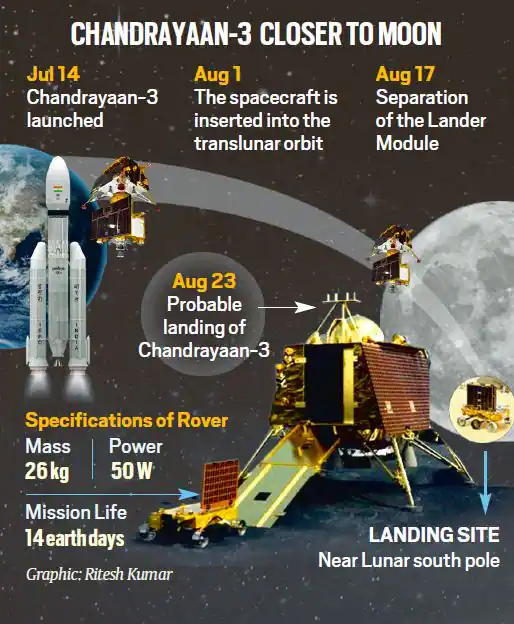On August 23, the Chandrayaan-3 lander will begin its final descent to make touchdown on the moon.
The Chandrayaan-3 lander, which carries within it the 26kh rover, separated from the propulsion module on Thursday for its onward journey to the surface of the moon on August 23. “Thanks for the ride, mate!” the lander module said as per a post by the Indian Space Research Organization (Isro) on X, formerly Twitter.
The lander module will descend further down from the current near-circular orbit of 153 x 163 km after a de-boosting man oeuvre planned for Friday evening. The propulsion module, meanwhile, will continue orbiting the moon and studying the spectral signatures of Earth using a payload that was tacked on to the mission in addition to the science experiments carried on board its predecessor.
By studying Earth from the moon, the Spectro-polarimetry of Habitable Planet Earth (SHAPE) will help scientists understand the markers of life on exoplanets.
Although the planned mission life for the propulsion module – which was added to the mission in place of the orbiter to help carry the lander rover to the moon – was three to six months, it is likely to keep functioning beyond that. “Meanwhile, the Propulsion Module continues its journey in the current orbit for months/years,” Isro said.
Since the orbiter of Chandrayaan-2 had functioned normally and the instruments on board carried out all the observations and experiments as intended, there was no need to include an orbiter component to Chandrayaan-3. However, transporting the lander module to the lunar orbit was still necessary, and the propulsion module had this limited task to perform.
The Chandrayaan-3 mission aims to accomplish what Chandrayaan-2 could not – achieving a soft landing and roving on the surface of the moon.
After the separation, the team will activate and test the instruments on board the lander, including the three scientific payloads, to check whether everything is functioning normally. The lander will carry out two orbit-reduction manoeuvres on its own, first getting into the circular 100 x 100 km orbit, and then further closer to the moon in the 100 x 30 km orbit. It is from here, on August 23, that the lander will begin its final descent to make touchdown on the moon.
The previous ISRO chief K Sivan described this powered descent as “fifteen minutes of terror.”Chandrayaan-2 had crash-landed just kilometers from its intended landing spot due to flaws in the algorithm of the onboard navigation software. The software did not provide for an immediate error-correction step when the engines produced a higher-than-intended thrust. The designers designed the algorithm to make the corrections after performing a few other urgent tasks. But this allowed the errors to accumulate and become unmanageable.
CREDIT: THE INDIAN EXPRESS


